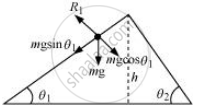Advertisements
Advertisements
प्रश्न
A solid sphere rolls down two different inclined planes of the same heights but different angles of inclination. (a) Will it reach the bottom with the same speed in each case? (b) Will it take longer to roll down one plane than the other? (c) If so, which one and why?
उत्तर १
(a) Yes (b) Yes (c) On the smaller inclination
(a)Mass of the sphere = m
Height of the plane = h
Velocity of the sphere at the bottom of the plane = v
At the top of the plane, the total energy of the sphere = Potential energy = mgh
At the bottom of the plane, the sphere has both translational and rotational kinetic energies.
Hence, total energy = `1/2mv^2 + 1/2Iomega^2`
Using the law of conservation of energy, we can write:
`1/2mv^2 + 1/2 Iomega^2 = mgh` ....(I)
For a solid sphere, the moment of inertia about its centre, `I = 2/3 mr^2`
Hence, equation (i) becomes:
`1/2 mv^2 + 1/2 (2/5 mr^2)omega^2 = mgh`
`1/2v^2 + 1/5r^2omega^2 =gh`
But we have the relation `v= r omega`
`:.1/2v^2 + 1/5v^2 = gh`
`v^2(7/10) = gh`
`v = sqrt(10/7 gh)`
Hence, the velocity of the sphere at the bottom depends only on height (h) and acceleration due to gravity (g). Both these values are constants. Therefore, the velocity at the bottom remains the same from whichever inclined plane the sphere is rolled.
(b), (c)Consider two inclined planes with inclinations θ1 and θ2, related as: θ1 < θ2
The acceleration produced in the sphere when it rolls down the plane inclined at `theta_1` is g sin `theta_1`
The various forces acting on the sphere are shown in the following figure.

R1 is the normal reaction to the sphere.
Similarly, the acceleration produced in the sphere when it rolls down the plane inclined at θ2is:
g sin θ2
The various forces acting on the sphere are shown in the following figure.

R2 is the normal reaction to the sphere.
θ2 > θ1; sin θ2 > sin θ1 ... (i)
∴ a2 > a1 … (ii)
Initial velocity, u = 0
Final velocity, v = Constant
Using the first equation of motion, we can obtain the time of roll as:
v = u + at
`:. t prop 1/a`
`[("For inclination" theta_1: t_1 prop 1/a_1), ("For inclination" theta_2 : t_2 prop 1/a_2)]` ...(iii)
From equations (ii) and (iii), we get:
t2 < t1
Hence, the sphere will take a longer time to reach the bottom of the inclined plane having the smaller inclination
उत्तर २
(a) Using law of conservation of energy,
`1/2mv^2 + 1/2Iomega^2 = mgh`
or `1/2mv^2 + 1/2(2/5 mR^2) v^2/R^2 = mgh`
or 7/10v^2 = gh or v = `sqrt((10gh)/7)`
Since h is same for both the inclined planes therefore v is the same.
b) `l = 1/2((g sin theta)/(1+K^2/R^2)) t^2 = (g sin theta)/2(1+2/5) t^2 = (5g sin theta)/14 t^2`
or t = `sqrt((14l)/(5g sin theta)`
Now, `sin theta = h/l` or l = `h/sin theta`
`:. t= 1/sin theta sqrt((14h)/"5g")`
Lesser the value of `theta` more will be t
c) Clearly, the solid sphere will take longer to roll down the plane with smaller inclination.
APPEARS IN
संबंधित प्रश्न
A solid sphere of mass 1 kg rolls on a table with linear speed 2 m/s, find its total kinetic energy.
If a rigid body of radius ‘R’ starts from rest and rolls down an inclined plane of inclination
‘θ’ then linear acceleration of body rolling down the plane is _______.
Two uniform solid spheres having unequal masses and unequal radii are released from rest from the same height on a rough incline. If the spheres roll without slipping, ___________ .
A uniform disc of mass 100g has a diameter of 10 cm. Calculate the total energy of the disc when rolling along with a horizontal table with a velocity of 20 cms-1. (take the surface of the table as reference)
A man is supported on a frictionless horizontal surface. It is attached to a string and rotates about a fixed centre at an angular velocity `omega`. The tension in the strings is F. If the length of string and angular velocity are doubled, the tension in string is now ____________.
A solid sphere is rolling on a frictionless surface with translational velocity 'V'. It climbs the inclined plane from 'A' to 'B' and then moves away from Bon the smooth horizontal surface. The value of 'V' should be ______.

An object is rolling without slipping on a horizontal surface and its rotational kinetic energy is two-thirds of translational kinetic energy. The body is ______.
If x = at + bt2, where x is the distance travelled by the body in kilometers while t is the time in seconds, then the unit of b is ______.
The kinetic energy and angular momentum of a body rotating with constant angular velocity are E and L. What does `(2E)/L` represent?
When a sphere rolls without slipping, the ratio of its kinetic energy of translation to its total kinetic energy is ______.
